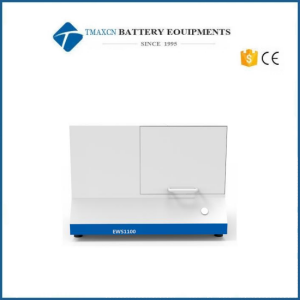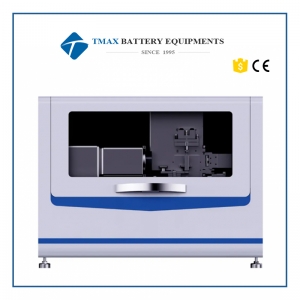products categories
- Battery Production Equipment Line
- Battery Lab Pilot Equipment Line
- Lithium Battery Pack Assembly Line
- Solid State Battery Assembly Line
- Sodium Ion Battery Production Line
- Supercapacitor Assembly Line
- Lithium Ion Battery Recycling Plant
- Dry Electrode Preparation Solution
- Perovskite Based Solar Cell Lab Line
- Li ion Battery Materials
- Cathode Active Materials
- Anode Active Materials
- Customized Battery Electrode
- Coin Cell Parts
- Lithium Chip
- Cylindrical Cell Parts
- Battery Current Collectors
- Battery Conductive Materials
- Electrolyte
- Metal Mesh
- Battery Binder
- Separator and Tape
- Aluminum Laminate Film
- Nickel Strip
- Battery Tabs
- Graphene Materials
- Nickel Felt
- Titanium Fiber Felt
- Battery
- Battery Pack Machine & Compoments
- Battery Pack Compoments
- Turnkey Solutions Battery Pack Assembly Line
- Cell Sorter
- Battery Pack Spot Welder
- Laser Welder
- Battery Charging Discharging Tester
- Battery Pack Aging Machine
- Battery Pack Comprehensive Tester
- CCD Visual Inspector
- Battery Pape Sticking Machine
- BMS Testing Machine
- Al Wire Bonding Machine
- Lithium Battery Machine
- Battery Tester & Analyzer
- Battery Safety Tester
- Material Characterization Tester
- Rolling Press Machine
- Spot Welding Machine
- Vacuum Mixer Machine
- Crimping/Disassembling Machine
- Vacuum Sealing Machine
- Electrolyte Filling
- Stacking/Winding Machine
- Electrode Cutter/Slitter
- Pouch Forming Machine
- NMP Solvent Treatment System
- Lithium Battery Production Plant
- Vacuum Glove Box
- Furnaces
- Coaters
- Hydraulic Press
- Ball Mill
- Planetary Centrifugal Mixer
- Cutting Machine
- Laboratory Machine
- Metal Foam
contact us
- If you have questions, please contact us, all questions will be answered
- WhatsApp : 8618659217588
- Email : David@tmaxcn.com
- Email : Davidtmaxcn@gmail.com
- Add : No. 39, Xinchang Road, Xinyang, Haicang Dist., Xiamen, Fujian, China (Mainland)
-
 Lab Electrolyte Wetting Measurement System Tester For Battery Electrolyte R&D
Lab Electrolyte Wetting Measurement System Tester For Battery Electrolyte R&D
Lab Electrolyte Wetting Measurement System For Battery Electrolyte R&D The Importance of Electrolyte Wetting Electrolyte is the core part of lithium-ion battery (LIB) research and development. It is not only an important medium to ensure ion transmission, but also an important basis for the LIB to obtain high voltage and high specific energy. Relevant parameters of the electrolyte and its wettability to the electrode and separator directly affect the performance of the LIB. The wetting effect of the electrolyte in the electrode is closely related to the compaction density, pore size, porosity and other parameters of the electrode itself. The evaluation of the wetting effect of the electrolyte in the electrode can be used as a key indicator for the process optimization of the electrode , and can also provide a new direction for the research and development of high-performance LIBs; Similarly, as one of the main materials of lithium-ion batteries, the separator also need a good wetting performance of the electrolyte. .Therefore, it is necessary to develop a kind of equipment that can effectively evaluate and test the stability of electrolyte wettability Traditional test methods Creative Solutions 1. Based on the capillary diffusion principle of electrolyte in the electrode and separator, quantitatively evaluate the difference of electrolyte infiltration; 2. Equipped with high-precision mechanical control and visual acquisition system, the test is stable and efficient; 3. It is applicable to the evaluation of infiltration of different electrodes, electrolyte, separator with different formula and process; 4. Real-time characterization of the wetting rate of the electrolyte in the sample. Software Interface Application Cases Wettability test of negative electrode of lithium-ion battery Experiments:Select four different positions of the same negative electrode and complete four groups of repeatability tests. The test results are shown in the figure & table; Result: the saturation curves of four repeated infiltration tests on the same negative electrode are basically consistent, and the standard deviation of the difference of the liquid level height at 50s is about 0.135, which indicates that the test consistency is good. Parameters and installation requirements Model TMAX-EWS1100 Stress control range 0-500g Stress resolution/accuracy 0.01g/±0.3%F.S Suction capacity 2uL INSTALLATION REQUIREMENT Voltage 220-240V Voltage variation tolerance ±10% Power <80W Environmental temperature 0-40℃ Environmental humidity <80%RH Net wet 5kg Dimension(W*D*H) 210*300*120 mm
-
 Lab Lithium Cell Electrolyte Wetting Tester For Battery Research
Lab Lithium Cell Electrolyte Wetting Tester For Battery Research
Lab Lithium Cell Electrolyte Wetting Tester For Battery Research The Importance of Electrolyte Wetting Electrolyte is the core part of lithium-ion battery (LIB) research and development. It is not only an important medium to ensure ion transmission, but also an important basis for the LIB to obtain high voltage and high specific energy. Relevant parameters of the electrolyte and its wettability to the electrode and separator directly affect the performance of the LIB. The wetting effect of the electrolyte in the electrode is closely related to the compaction density, pore size, porosity and other parameters of the electrode itself. The evaluation of the wetting effect of the electrolyte in the electrode can be used as a key indicator for the process optimization of the electrode , and can also provide a new direction for the research and development of high-performance LIBs; Similarly, as one of the main materials of lithium-ion batteries, the separator also need a good wetting performance of the electrolyte. .Therefore, it is necessary to develop a kind of equipment that can effectively evaluate and test the stability of electrolyte wettability Traditional test methods Creative Solutions 1. Based on the capillary diffusion principle of electrolyte in the electrode and separator, quantitatively evaluate the difference of electrolyte infiltration; 2. Equipped with high-precision mechanical control and visual acquisition system, the test is stable and efficient; 3. It is applicable to the evaluation of infiltration of different electrodes, electrolyte, separator with different formula and process; 4. Real-time characterization of the wetting rate of the electrolyte in the sample. Software Interface Application Cases Wettability test of negative electrode of lithium-ion battery Experiments:Select four different positions of the same negative electrode and complete four groups of repeatability tests. The test results are shown in the figure & table; Result: the saturation curves of four repeated infiltration tests on the same negative electrode are basically consistent, and the standard deviation of the difference of the liquid level height at 50s is about 0.135, which indicates that the test consistency is good. Parameters and installation requirements Model TMAX-EWS1100 Stress control range 0-500g Stress resolution/accuracy 0.01g/±0.3%F.S Suction capacity 2uL INSTALLATION REQUIREMENT Voltage 220-240V Voltage variation tolerance ±10% Power <80W Environmental temperature 0-40℃ Environmental humidity <80%RH Net wet 5kg Dimension(W*D*H) 210*300*120 mm
-
 Lab Cylindrical Cell Electrolyte Wetting Measurement System
Lab Cylindrical Cell Electrolyte Wetting Measurement System
Lab Cylindrical Cell Electrolyte Wetting Measurement System The Importance of Electrolyte Wetting Electrolyte is the core part of lithium-ion battery (LIB) research and development. It is not only an important medium to ensure ion transmission, but also an important basis for the LIB to obtain high voltage and high specific energy. Relevant parameters of the electrolyte and its wettability to the electrode and separator directly affect the performance of the LIB. The wetting effect of the electrolyte in the electrode is closely related to the compaction density, pore size, porosity and other parameters of the electrode itself. The evaluation of the wetting effect of the electrolyte in the electrode can be used as a key indicator for the process optimization of the electrode , and can also provide a new direction for the research and development of high-performance LIBs; Similarly, as one of the main materials of lithium-ion batteries, the separator also need a good wetting performance of the electrolyte. .Therefore, it is necessary to develop a kind of equipment that can effectively evaluate and test the stability of electrolyte wettability Traditional test methods Creative Solutions 1. Based on the capillary diffusion principle of electrolyte in the electrode and separator, quantitatively evaluate the difference of electrolyte infiltration; 2. Equipped with high-precision mechanical control and visual acquisition system, the test is stable and efficient; 3. It is applicable to the evaluation of infiltration of different electrodes, electrolyte, separator with different formula and process; 4. Real-time characterization of the wetting rate of the electrolyte in the sample. Software Interface Application Cases Wettability test of negative electrode of lithium-ion battery Experiments:Select four different positions of the same negative electrode and complete four groups of repeatability tests. The test results are shown in the figure & table; Result: the saturation curves of four repeated infiltration tests on the same negative electrode are basically consistent, and the standard deviation of the difference of the liquid level height at 50s is about 0.135, which indicates that the test consistency is good. Parameters and installation requirements Model TMAX-EWS1100 Stress control range 0-500g Stress resolution/accuracy 0.01g/±0.3%F.S Suction capacity 2uL INSTALLATION REQUIREMENT Voltage 220-240V Voltage variation tolerance ±10% Power <80W Environmental temperature 0-40℃ Environmental humidity <80%RH Net wet 5kg Dimension(W*D*H) 210*300*120 mm
-
 Electrolyte Wetting Testing System
Electrolyte Wetting Testing System
Electrolyte Wetting Testing System Introduction Combining the visual acquisition system and the capillary action of the electrolyte to evaluate the wetting differences of different electrodes, electrolytes, diaphragm formulations and processes. Characteristic 1. Based on the principle of capillary diffusion of electrolyte in the electrodes and separators, quantitatively evaluate the difference in electrolyte infiltration; 2. Equipped with high-precision mechanical control and visual acquisition system, the test is stable and efficient; 3. Suitable for evaluation of infiltration differences of different electrodes, electrolytes, separator formulas and processes; 4. Characterize the infiltration rate of electrolyte in the sample in real time. Applications 1. Electrolyte: Performance Evaluation 2. Electrode: Consistency Assessment 3. Optimization of material: Electrode Surface Treatment Processes Description 1. Principle of Electrode Wetting The Lucas–Washburn Equation is commonly used to describe the dynamic of liquid absorption in electrode pores, as represented by the equation below: 1) r represents the radius of the capillary (m), 2) σ represents the surface tension of the imbibition fluid (N/m), 3) η represents the viscosity of the imbibition fluid (Pa*s), 4) θ represents the contact angle of the wet phase (°), 5) h represents the liquid suction height (m), 6) t represents the liquid suction time, 7) cr represents a fixed value, called the formal radius. 2. Applications 1) Electrolyte: Performance Evaluation 2) Electrode: Consistency Assessment 3) Optimization of material: Electrode Surface Treatment Processes 2.1 Capillary Wetting System-EWS Series Key Features: 1) Equipped with a high-precision vision testing system for stable and efficient testing repeatability. 2) In-situ real-time characterization of electrolyte wetting rateon negative electrode sheets of lithium-ion batteries. 3) Applicable Samples: Negative electrode sheets. 4) The greater the compacticion of the electrode sheet, the lower the porosity, resulting in poorer electrolyte wetting. 2.2 Weight Wetting System-ETS Series Key Features: 1) Equipped with a high-precision weighing system for stable and efficient testing repeatability. 2) In-situ real-time characterization of electrolyte wetting rate on positive and negative electrode sheets of lithium-ion batteries. 3) Applicable samples: Anode electrodes & Jelly Cells 2.3. Height Wetting System-CHT Series Key Features: 1) Equipped with a high-precision vision acquisition system for stable and efficient testing repeatability. 2) In-situ real-time characterization of electrolyte wetting rate on positive and negative electrode sheets of lithium-ion batteries. 3) Applicable samples: Anode electrodes Application Cases 1. Capillary Wetting System-EWS Series The greater the density of the electrode, the lower the porosity and the worse the electrolyte wettability. 2. Weight Wetting System-ETS Series Trimming three sets of negative electrode sheets from the same batch (65*70mm) 3. Height Wetting System-CHT Series The slopes of the 3 tested electrodes are consistent with each other, so is the wetting consistency of their electrolytes. Specifications Capillary Wetting System-EWS Series Weight Wetting System-ETS Series Height Wetting System-CHT Series
 ru
ru
 +86 13174506016
+86 13174506016 David@tmaxcn.com
David@tmaxcn.com
